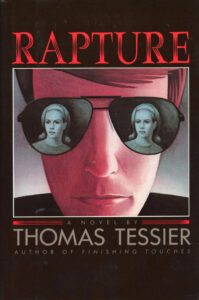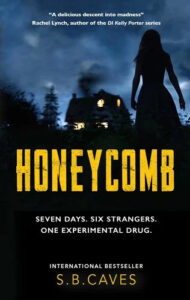In my latest dark thriller, Honeycomb, a washed-up singer takes part in a mysterious—and ultimately nefarious—social experiment that quickly turns catastrophic. Exploring the relationship between celebrities and fans, as well as the addictive nature and relentless pursuit of fame, I drew inspiration from many classic novels that have tackled the harrowing and invasive themes of stalking and obsession. Here are a few chilling examples of the subgenre, with some of the most twisted plots and even more twisted antagonists.

Rapture by Thomas Tessier
When successful businessman Jeff Lisker returns to his hometown for his father’s funeral, he uses it as an opportunity to seek out his old high school crush, Georgianne, only to learn that she is happily married with a teenage daughter. Undeterred by her marital status, Jeff is determined to wriggle back into Georgianne’s life at any cost, hoping to kindle a flame that they almost (but never) had twenty years earlier.
Jeff goes from being almost pathetically pestering to persistently frightening after his affections are rebuffed. Desperate to escape the friend zone which he has been banished to, Jeff will stop at nothing to completely isolate and ensnare Georgianne. What is particularly scary about Jeff’s manipulative pursuit is how he normalizes the violence and chaos he creates, in the hope of forcing a woman to love him. Beneath the veneer of his professional persona, he harbors the sort of sociopathic toxicity that you have seen on display in a dozen true crime documentaries. Jeff Lisker could be your neighbor, your colleague, or even a relative.

The Woman in the Purple Skirt by Natsuko Imamura
There is something oddly dreamy and effortlessly troubling about this short but memorable novel by Natsuko Imamura. The story is told from the perspective of our narrator, The Woman in the Yellow Cardigan, as she slips into a deep and seemingly motiveless infatuation with her new colleague, whom she refers to as The Woman in the Purple Skirt. What unravels is a subtle study of loneliness; our narrator is apparently unaware of how bizarre and downright creepy her spying becomes, as she shadows the subject of her curiosity through the mundane minutiae of their work as housekeepers at a hotel, before invading the most intimate aspects of her private life. The Woman in the Yellow Cardigan’s behavior, while never overtly threatening, is precisely unsettling because of how normal she makes her stalking seem. There is an unrelenting persistence to her observations that go mostly unnoticed throughout, yet the thought of someone dedicating all their energy and mental bandwidth to an unwitting participant is truly chilling.

Audition by Ryū Murakami
What’s really interesting and disturbing about Audition, is that it explores the extremes of obsession from both sides of the coin. In one instance, we have our protagonist, the widow Aoyama, who goes to the drastic length of setting up a rigged audition for a film that will never get made, with the sole intention of weeding out a suitable candidate to start a relationship with. From the hundreds of desperately ambitious actresses that make the initial shortlist, Aoyama encounters Yamasaki, a beautiful and mysterious woman that is young enough to be his daughter, with whom he is instantly besotted. Despite knowing very little about Yamasaki, Aoyama falls deeply in love with her, unable to think or focus on anything else. It is only as the plot develops and we are given subtle hints and later, explicit depictions of her ominous past, that we understand the consequences of their coupling. Despite warnings from those around him, Aoyama is the last to realize that his unethical romantic scheme has unearthed a dangerously ill individual, and what starts as something of a fairytale affair turns nightmarish, fast.
Quite simply, Yamasaki is terrifying, rivaling Misery’s Annie Wilkes as one of fiction’s most memorably unhinged characters.

The Shards by Bret Easton Ellis
This masterfully layered, epic autofiction thriller recounts the author’s final years at a prestigious high school in the early eighties. The arrival of Robert Mallory, a gorgeous new boy who inserts himself into Ellis’s elite circle of friends, kickstarts the novel’s central mystery. After a few acute observations, Ellis almost intuitively feels that something is deeply amiss with Mallory, though Ellis is seemingly the only one picking up on all his apparent lies and contradictions. At the same time, there is a sadistic serial killer known as The Trawler stalking LA, and a strange, Manson-like satanic cult running wild through the city. While dealing with the complexities of his deteriorating social life, Ellis is unable to shake the idea that Robert is in fact The Trawler, and this unwavering conviction eventually leads to a violent confrontation.
The depiction of The Trawler’s atrocities is beyond horrific and genuinely unnerving. Though, what might not be apparent upon a first read is just how clever this novel really is. There is so much going on beneath the surface here. The Shards almost demands a second and third readthrough so we can more closely analyze our narrator’s intentions and behavior toward this attractive ‘God’ that appears to throw Ellis’s life into flux. It is then that we collate clues that might have been missed originally. Is Mallory really the problem, or is Ellis’s paranoid fascination with him blowing things out of proportion? Could Mallory really be the maniacal murderer on the rampage, or is our narrator’s unhealthy fixation a symptom of something darker?

Bad Ronald by Jack Vance
While the 1974 made-for-TV adaptation of Bad Ronald was a creepy though ultimately tame thriller, the source material is anything but. Vance’s novel, about an oddball loner living in a hidden room in his house as a way of evading authorities after he brutally murders a young girl in his neighborhood, is pure nightmare fuel for any new homeowner. Ronald’s mother, the only person aware of his secret dwelling, dies during a surgery, and a new family eventually moves into the house. Ronald must remain concealed and confined in the secret room, sneaking out whenever he can to steal food, haunting the house with his presence. Though, it is during the long months of self-imprisonment that Ronald’s already fractured mental state begins to erode further, as he concocts vivid fantasies about the three teenage daughters now occupying his home, whom he spies on through holes in the walls.
Such a twisted plot might sound slightly farfetched, but not if we consider the real-life case of Daniel LaPlante just over a decade later, who notoriously lived unnoticed in a family’s house for almost a year before going on to commit murder, his crimes eerily echoing those detailed in Bad Ronald.
Though the book is dated, the sense of dread it evokes remains palpable. In more recent years, social media and advancements in home security cameras have helped raise awareness of phrogging, the term given to the practice of living uninvited in someone else’s home. It is an incredibly scary concept, especially if you consider that someone as disturbed as Ronald could be scuttling around your house undetected…
The Fan, by Peter Abrahams
As the name implies, The Fan examines the intricacies of fanaticism, and the motivations that provoke knife salesman and avid Red Sox fan, Gil Renard, to shift the focus of his mania to the team’s superstar new signing, Bobby Rayburn.
While the book was competently adapted in 1996 by Tony Scott, with an all-star cast including Robert de Niro as Renard and Wesley Snipes as the object of his obsession, it wisely avoided many of the darker aspects of the book, which almost threaten to turn Renard into a template psychopath. The novel infuses a level of grittiness with its detailed portrayal of Gil’s violent lifestyle that is appropriately absent in its glossy Hollywood counterpart.
Yet, the most menacing aspect of Abraham’s taut suspense thriller is the very convincing idea that there could be hundreds, if not thousands of men like Gil Renard walking the streets right now; an extreme class of fan that is capable of inflicting violence at the slightest disagreement with their derangement. You may have already rubbed shoulders with them at a local bar. Just be careful who you cheer for when you’re next watching a game.
***


















